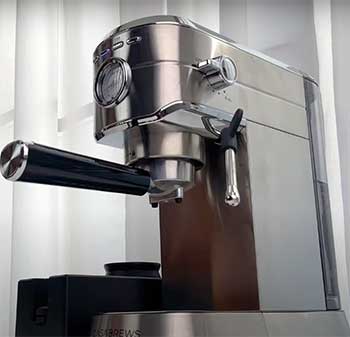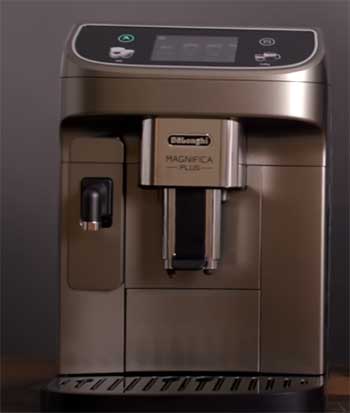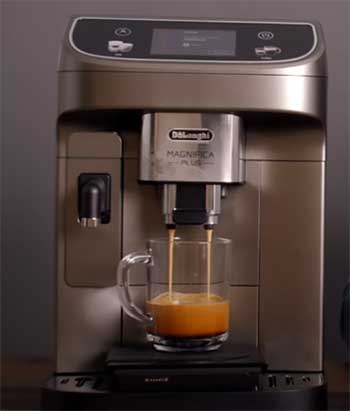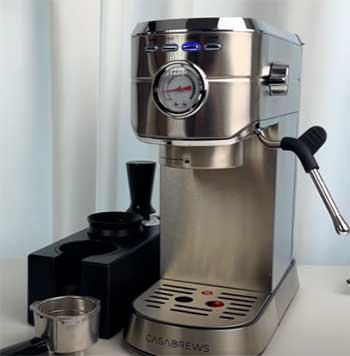As a self-professed coffee enthusiast, I’ve spent countless hours tinkering with espresso machines, chasing that perfect shot. It’s a journey many of you are likely on right now, standing at a crossroads between two popular brands: Casabrews and De’Longhi.
My goal here is to share my hands-on experience and analytical breakdown of these two contenders. I’ll walk you through my findings, comparing the Casabrews line with the ever-popular De’Longhi Magnifica.
This isn’t just a spec sheet comparison; it’s about helping you understand which machine will truly fit into your morning ritual and deliver the coffee you crave.
A Brief Comparison Table
| Feature Showdown | Casabrews (CM5418 Model) | De’Longhi Magnifica (ESAM3300) | My Take |
| Machine Type | Semi-Automatic Espresso Machine | Super-Automatic Espresso Machine | Do you want to be the pilot or the passenger on your coffee journey? |
| Grinder | External (or pre-ground) | Integrated Conical Burr Grinder | The Magnifica’s built-in grinder is a game-changer for convenience and freshness. |
| Milk Frothing | Manual Steam Wand | Manual Steam Wand (Panarello) | Both require some practice, but the hands-on control is rewarding. |
| User Experience | More hands-on, requires practice | “Bean-to-cup” simplicity | Casabrews is for the hobbyist; De’Longhi is for the efficiency seeker. |
| Footprint | Generally more compact | Taller and deeper | Measure your counter space twice, buy once! |
| Pressure | 20 Bar Pump | 15 Bar Pump | Higher bars don’t always mean better espresso. It’s all about consistency. |
| Customization | You control grind, tamp, and shot time | Programmable drink length and strength | De’Longhi offers programmed ease, while Casabrews gives you analog freedom. |
| Price Point | Budget-friendly | Mid-range investment | You’re paying for automation and a built-in grinder with the De’Longhi. |
| Best For | Aspiring baristas on a budget | Convenience-lovers who want fresh espresso | Your personality and lifestyle will be the deciding factor here. |
My Journey Into Home Espresso
My countertop has seen its fair share of coffee makers over the years, from simple drip brewers to complex, gleaming machines that promised the world. The quest for the perfect home espresso is a passion project, a daily ritual that sets the tone for the rest of my day.
It’s a journey that led me to a fascinating crossroads: the choice between a more hands-on, budget-conscious machine like those from Casabrews and a workhorse of the super-automatic world, the De’Longhi Magnifica.
This isn’t just about comparing two appliances; it’s about comparing two distinct philosophies of home coffee making.
I wanted to understand what makes each machine tick, not just from a technical standpoint but from a user’s perspective. What does it feel like to wake up and use one of these machines every morning?
Who are they really for?
I decided to put them through their paces, living with them, learning their quirks, and discovering their strengths. This is my story of that comparison, a detailed account of my time with both a Casabrews espresso machine and the De’Longhi Magnifica, designed to help you figure out which path is the right one for your own coffee adventure.
The Allure of Casabrews: A Hands-On Approach

My first encounter with a Casabrews machine, specifically the CM5418 model, was driven by curiosity and an appreciation for its aesthetics and price tag.
It presents itself as a compact, stylish unit that promises to deliver authentic, barista-quality espresso without demanding a second mortgage.
It’s a semi-automatic machine, which for me, is where the fun begins.
This means I’m in the driver’s seat. I choose the beans, I grind them, I tamp the puck, and I decide when to start and stop the extraction.
The Good Stuff: Pros of the Casabrews Experience
From the moment I unboxed it, I was struck by the compact design. For anyone with limited counter space, this is a huge plus. It slid neatly into a corner of my kitchen that a larger machine would have completely dominated.
The stainless steel finish gave it a premium look that defied its budget-friendly price.
The key feature that Casabrews often touts is its 20-bar pressure pump. Now, in the world of espresso, there’s a lot of debate about whether anything over 9-15 bars makes a tangible difference. What I can say from my experience is that the pressure felt consistent.
When I dialed in my grind and tamp correctly, the machine was capable of producing a surprisingly rich shot with a respectable layer of crema. It took some trial and error, a dance of adjusting the grind size on my separate grinder and the tamping pressure, but when I hit that sweet spot, the results were genuinely satisfying.
The manual steam wand was another area where I felt a direct connection to the coffee-making process. It’s not the most powerful wand I’ve ever used, but with a bit of practice, I was able to create decent microfoam for lattes and cappuccinos.
The process is engaging; you have to pay attention to the sound, the feel, and the look of the milk as it texturizes. It’s a skill, and mastering it on the Casabrews machine felt like a real accomplishment.
Ultimately, the biggest pro for me was the control. I could experiment with different beans, grind sizes, and tamping pressures to see how they affected the final taste. It forced me to learn and understand the variables of espresso extraction, making me a more knowledgeable home barista in the process.
For someone who enjoys the ritual and the craft of coffee, this level of involvement is a massive selling point.
The Reality Check: Cons of The Casabrews Path
Of course, this hands-on approach comes with its own set of challenges. My journey with the Casabrews wasn’t always filled with perfectly pulled shots. The need for a separate, quality grinder is non-negotiable.
Using pre-ground coffee simply won’t cut it if you’re serious about espresso. This adds an extra cost and another piece of equipment to your setup. The quality of your grinder will directly impact the quality of your espresso, perhaps even more so than the machine itself.
Consistency can also be a moving target. Because I was controlling so many variables, it was easy to get a “sink shot”—a shot of espresso that’s so bad it goes straight down the drain.
An uneven tamp, a slightly off grind size, or a moment’s hesitation in stopping the shot could all lead to a bitter or sour result. While I enjoy this process, someone looking for a quick, reliable caffeine fix before rushing out the door might find it frustrating.
The build quality, while aesthetically pleasing, is where the budget-friendly nature becomes more apparent. The portafilter is lighter than those found on more premium machines, and some of the components have a more plastic-y feel.
It’s not a deal-breaker, but it’s a noticeable difference when you compare it side-by-side with a more expensive machine. The steam wand, while capable, also requires more time and patience to get the milk just right compared to the more powerful wands on higher-end machines.
The De’Longhi Magnifica: The Beauty of Automation

Switching gears to the De’Longhi Magnifica ESAM3300 was like stepping into a different world.
This is a super-automatic machine, and its primary promise is convenience without sacrificing the quality of freshly ground beans.
The “bean-to-cup” experience is its mantra.
You pour whole beans into the hopper, fill the water tank, and with the press of a button, it grinds, tamps, and brews a shot of espresso.
The Upside: Pros of Living the Automated Life
The most immediate and obvious pro is the sheer convenience. Waking up, walking to the machine, and having a freshly ground, freshly brewed espresso in under a minute is nothing short of magical on a busy morning.
There’s no mess from grinding, no tamping, and no guesswork. You press a button, and coffee happens. For someone whose priority is a consistently good cup of coffee with minimal effort, the Magnifica is an absolute dream.
The integrated conical burr grinder is the star of the show. Not only does it save counter space, but it also ensures that every single cup is made from freshly ground beans, a critical factor for flavor.
The grinder is adjustable, allowing me to choose the fineness of the grind, which gives a surprising degree of control for a super-automatic. I could dial it in for different types of beans, aiming for a more balanced extraction.
The control panel, while looking a bit dated with its dials and buttons, is incredibly intuitive. I could easily adjust the coffee strength and the volume of the shot.
This meant I could have a strong, short shot in the morning and a milder, longer one in the afternoon, all with the turn of a dial. This level of programmable customization is a huge benefit.
Consistency is where the Magnifica truly shines. Because the machine handles the grinding and tamping, it eliminates the human error that can plague a semi-automatic machine. Every shot is remarkably consistent.
This reliability is a godsend for anyone who doesn’t want to play the role of a scientist before their first cup of coffee. The manual Panarello-style steam wand is also quite forgiving for beginners. It’s designed to easily create froth, though it produces a stiffer, more bubbly foam rather than the silky microfoam prized for latte art.
For a quick and easy cappuccino, however, it works wonderfully.
The Downsides: Cons of The Convenient Choice
This convenience and automation do come with a price, both literally and figuratively. The Magnifica is a significant investment compared to most Casabrews models. You’re paying for the grinder, the brewing mechanism, and the complex internal workings that make the magic happen.
The trade-off for this automation is a degree of detachment from the coffee-making process. I missed the ritual of grinding the beans, the satisfying feel of a perfectly tamped puck, and the control of manually pulling a shot. For coffee hobbyists, the Magnifica can feel a bit like a black box.
You put beans in one end, and coffee comes out the other, but you lose that tactile connection to the craft.
The size of the machine is also a consideration. It’s taller and deeper than the sleek Casabrews, demanding a more significant chunk of countertop real estate. Maintenance is another factor. While daily use is simple, super-automatics require regular internal cleaning cycles and descaling to keep them running smoothly.
The brew unit needs to be removed and rinsed periodically, which is an extra step that semi-automatic users don’t have to worry about in the same way.
Finally, while the espresso is consistently good, it might not reach the sublime peaks that are possible with a semi-automatic machine when everything is dialed in perfectly. The Magnifica produces a very good, classic Italian-style espresso.
However, for those chasing the nuanced flavors of third-wave, single-origin light roasts, the level of control offered by a semi-automatic like the Casabrews might be more appealing.
The Core Differences Between Casabrews And De’Longhi That Matter
When I strip away the branding and the marketing, the choice between Casabrews and the De’Longhi Magnifica boils down to a few fundamental differences in philosophy.
- The User Experience: Artist Vs. Engineer

Using the Casabrews machine felt like being an artist.
I had a blank canvas and a set of tools, and the final product was a direct result of my skill, intuition, and effort.
Some days the art was beautiful, and other days it was… abstract.
It’s a journey of continuous improvement and hands-on learning.
The De’Longhi Magnifica, on the other hand, made me feel like an engineer overseeing an efficient process.
I set the parameters—grind size, strength, volume—and the machine executed the task with precision and repeatability.
The result was consistently good, a reliable output from a well-oiled machine. It’s less about the romance of the process and more about the excellence of the outcome.
- Customization and Control
This is where the two diverge most sharply. With Casabrews, customization is granular and manual. You can endlessly tweak every variable, from the brand of beans to the seconds of extraction. This is perfect for the tinkerer, the experimenter who wants to understand the ‘why’ behind a great shot of espresso.
The De’Longhi offers customization through programming. You can set your preferences and let the machine replicate them perfectly every time.
It’s about finding your ideal settings and then enjoying that consistency day in and day out. It’s a “set it and forget it” approach to customization, which is incredibly appealing for many people.
- Maintenance And Durability
Both machines require care to ensure their longevity. With the Casabrews, the daily cleanup is fairly straightforward: wipe down the steam wand, rinse the portafilter, and empty the drip tray. The long-term maintenance is minimal.
The De’Longhi Magnifica requires a more structured maintenance routine. The machine will tell you when it needs to be descaled, and you have to follow the process carefully.
The internal brew group needs to be removed and rinsed regularly to prevent coffee grounds from building up. It’s not difficult, but it is a necessary chore to protect your investment. In terms of durability, De’Longhi has a long-standing reputation for building robust, long-lasting machines.
The Magnifica line, in particular, is known for being a workhorse. Casabrews, being a newer and more budget-oriented brand, has a shorter track record, but the simplicity of its design means there are fewer complex parts that could potentially fail.
A Machine For Every Personality

After spending quality time with both the Casabrews and the De’Longhi Magnifica, my conclusion is that there is no single “better” machine.
The best machine is the one that aligns with your lifestyle, your budget, and your personality.
I would recommend a Casabrews machine to you if you are on a tighter budget but still want to drink real espresso.
It’s for you if you are curious about the craft of coffee and want to get your hands dirty.
If you see coffee making as a hobby and a ritual, and you have the patience to learn and experiment, the Casabrews will be an incredibly rewarding and affordable entry point into the world of authentic espresso.
You will need to be prepared to buy a separate grinder and accept that not every shot will be perfect, but the journey of learning will be half the fun.
On the other hand, I would wholeheartedly recommend the De’Longhi Magnifica to you if your primary goal is to have delicious, fresh espresso with the utmost convenience. If you have a busy lifestyle and value speed and consistency above all else, this machine is your answer.
If the thought of grinding, tamping, and timing a shot before your morning meeting fills you with dread, the Magnifica will be your faithful servant. It’s a bigger investment, but you are paying for reliability, convenience, and the luxury of a “bean-to-cup” experience every single day.
You can trust it to deliver a great cup of coffee every time you press that button.
Ultimately, the choice is yours. Do you want to be the hands-on barista, celebrating the process and the occasional perfect shot?
Or do you want to be the discerning coffee drinker who values a consistently excellent result with minimal fuss? By understanding what you truly want from your coffee experience, you’ll know exactly which of these capable machines belongs on your countertop.
Frequently Asked Questions (FAQ)
Casabrews is a brand of kitchen appliances, specializing in coffee machines, that is owned by a Chinese appliance manufacturer.
Yes, Casabrews espresso machines are manufactured in China.
Brad Pitt is a brand ambassador for De’Longhi and is featured in advertisements for their super-automatic espresso machines, including the Dinamica Plus.
Wrapping Up
After living with both machines, my final takeaway is this: the “best” machine is entirely personal. The Casabrews turned my coffee making into an engaging, hands-on ritual, rewarding my effort and patience.
The De’Longhi, in contrast, delivered flawless espresso with push-button simplicity, respecting my time on busy mornings.
Ultimately, you must decide what you value more: the journey of becoming a home barista or the convenience of a consistently perfect cup. Your answer will point you directly to the right machine for your kitchen.
